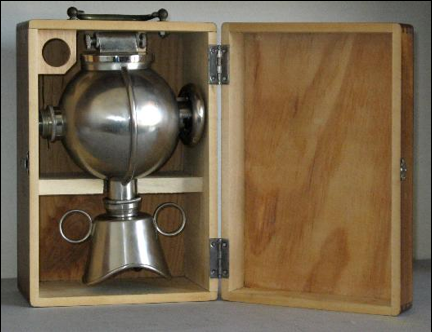Ombrédanne Ether Inhaler
Ref. M1
History
(From the Internet)
In 1907, following 2 fatal anesthetic accidents Pr. Nélaton gave his pupil Louis Ombrédanne the task of creating a safe anesthetic device. The prototype, made by him and his chauffeur consisted of an elliptical metal English sweets tin which acted as a reservoir which was fitted with felt to absorb ether, a graduated air inlet, and a respiratory reserve chamber. The inhaler was tested on more than 300 patients over 6 months and was shown to the Society of Surgery. It rapidly became a great success. Modifications to the design quickly followed. The elliptical reservoir became spherical, the mask and the reservoir were separated, but the design hardly changed apart from the addition of oxygen and carbon dioxyde. The Collin Company sold it (more than 80.000 units) around the world. The operation of the inhaler was very simple. In the zero position, the ether flow was cut and the patient inhaled only equal parts of a gas mixture of fresh and inhaled air. In position 8 the ether reservoir was completely open and the patient inhaled a mixture of ether and inhaled air, but the minimal amount of fresh air admitted was insufficient to correct the hypoxemia and hypercapnia. The intermediate position between 0 and 8 allowed a balanced control of anesthesia. Thanks to Ombrédanne, inhalation anesthesia made great strides towards safety. Against this the simplicity of the device, which allowed its use by a large number of non-specialists, was the delay in the development of anesthesia as a medical specialty in France until the late 1940’s.
(Anesthesiology 2007; 107: A1185)
This item comes originally from Bhannes Sanitarium and was gracefully offered to the collection in its original wooden box by Dr. Wagih Sabbagh.
I have seen this inhaler still in use in the early fifties on very rare occasions.
The following pictures from the Internet show removable rubber covers used on the masks. Find out more about the technical details of this inhaler.



Read up about details and memories of its use (written by the late Dr. Robert Khouri - in French).